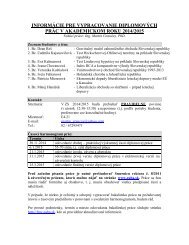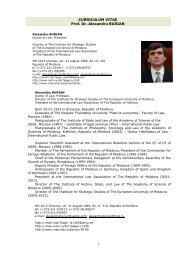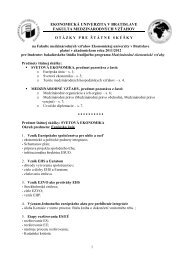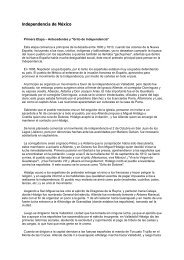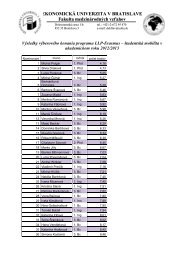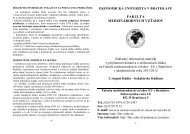4 - Fakulta medzinárodných vzťahov - Ekonomická univerzita v ...
4 - Fakulta medzinárodných vzťahov - Ekonomická univerzita v ...
4 - Fakulta medzinárodných vzťahov - Ekonomická univerzita v ...
You also want an ePaper? Increase the reach of your titles
YUMPU automatically turns print PDFs into web optimized ePapers that Google loves.
The aim of the article is to describe and analyse economic development, sum up, listand explain main factors that might have led to the general slowdown and instability of theJapanese economy in the 1990s. The author tries to explain basic economic relations in theJapanese economy and describe its development in the so-called lost decade on the backgroundof hasty development in the current world economy.Factors of the slowdown in the 1990s and problems of the Japanese economy arediscussed by a number of renowned authors. The topic was examined in a more complex wayby e.g. Drysdale and Gower (The Japanese Economy, 1998), West or Posen. Posen withKuttner in their study “The Great Recession: The Lessons for Macroeconomic Policy fromJapan (2001) used the term “Great recession” for the development in Japan in the 1990s tostress the specifics of this period in comparison with the development in previous decades anddevelopment in other countries or regions. Less known is Edward L. Lincoln, whose bookArthritic Japan: The Slow Pace of Economic Reform (2001) thoroughly analyses individualphases of an economic cycle and approaches of government authorities to solving majoreconomic issues. Best known Japanese authors of a number of books and papers on theJapanese economy known even in American National Bureau for Economic Research or asmembers of research teams of Japanese government and Central Bank of Japan (BOJ) areTakatoshi Ito (e.g. The Japanese Economy, 1992) and Hiroshi Yoshikawa (e.g. Japan´s LostDecade, 2002).Selected issues of the Japanese economy (e.g. the bubble in asset markets, liquiditytrap, deflation, credit crunch, factors of limited efficiency of fiscal expansion in Japan in the1990s or causes and impacts of financial sector crisis) were studied also by other authors.Factors of slowdown and specifics of economic cycles were discussed by a Nobel prize winnerin the field of economics for 2004 E. C. Prescott a F. Hayashi (study The 1990s in Japan: a LostDecade, 2002). Causes and impacts of a liquidity trap and deflation were investigated by P.Krugman (e.g. article It’s Baaack! Japan’s Slump and the Return of the Liquidity Trap of 1998and following articles). Numerous Japanese authors, e.g. K. Okina, S. Shiratsuka or BOJgovernor M. Shirakawa analysed causes and impacts of a so-called bubble in the asset marketsin the early 1990s.OECD and IMF publications must also be mentioned, mainly empirical studies ofeconomic cycles in developed countries published in different issues of OECD EconomicSurveys or IMF World Economic Outlook. Very good theoretical studies and information onthe condition and issues of the Japanese economy can be found e.g. in IMF Selected Issues.The text of this study is divided into three parts, which chronologically map thedevelopment in the 1990s. The first part is devoted to a bubble boom and recession after thedisruption of the bubble in asset markets. The second part reminds the development in 1994-1996, when the Japanese economy was stable for a certain time; nevertheless seriousmacroeconomic and structural problems which influenced the development in the successiveperiod (particularly deflation, liquidity trap, imbalance of public finances and problems of thefinancial system) emerged and deepened simultaneously. The last part describes the end of thedecade with the emphasis on the analysis of efficiency of economic policy measures in thisperiod and settling of financial system crisis. Attention is paid to impacts of the crisis in East-South Asia and Japanese links to these regions.1 Bubble boom and recession in the beginning of the 1990sStrong growth in the Japanese economy at the end of the 1980s was paradoxicallyencouraged by a strong appreciation of Japanese currency (yen, JPY). 2 This rise is, however,2 Yen appreciated after a coordinated foreign exchange intervention of G5 countries againstUSD strengthening of 1985, a so-called Plaza Accord. The impulse for JPY appreciation and130 ○ MEDZINÁRODNÉ VZŤAHY, 2012, 4



